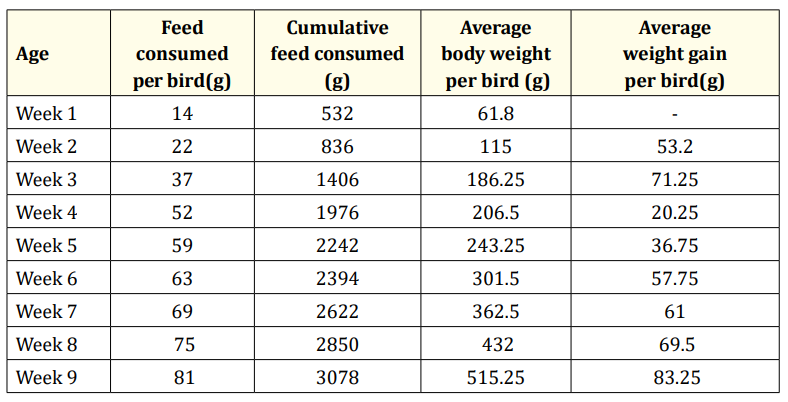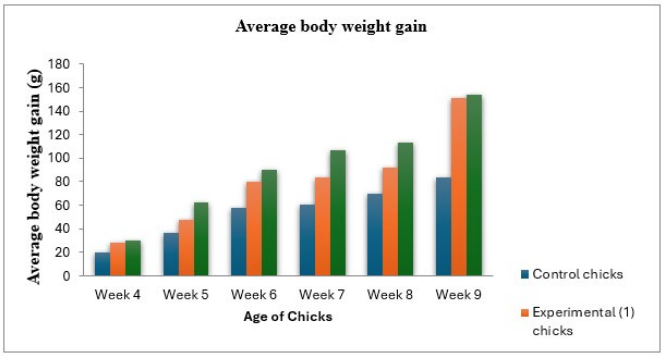D Addline Esther Pushparani, L Jeyapraba*, Logeshwari TR and D Lakshmi Prabha
Zoology Department and Research Centre, Sarah Tucker College, Manonmaniam Sundaranar University, Tirunelveli, Tamil Nadu, India
*Corresponding Author: L Jeyapraba, Zoology Department and Research Centre, Sarah Tucker College, Manonmaniam Sundaranar University, Tirunelveli, Tamil Nadu, India.
Received: August 20, 2024; Published: September 30, 2024
Citation: L Jeyapraba., et al. “Effect of Supplementary Feeds Dried Sardine, Moringa Oleifera and Histopathological Studies in the Selected Organs of Native Breed Chicks”. Acta Scientific Veterinary Sciences 6.10 (2024): 47-51.
Indigenous /native breeds of chickens play an important role in rural economic development in most of the developing and underdeveloped countries. The impact of supplement feeds Moringa oleifera and Dried sardine, in the growth assessment of country fowl chicks were analysed. In the present study the chicks were divided into three groups, Control, Experimental (1), Experimental (2) respectively. The control chicks were fed only with starter and grower feeds. In addition, with the starter and grower feeds, the Experimental (1) chicks were fed with nutritional supplement Dried Sardine, the Experimental (2) chicks were fed with both the supplements dried Sardine and Moringa oleifera. It was seen that the addition of these supplements contributed to an increase in the average body weight as compared with control birds. After conducting histopathological analysis, it was found that in Experimental (1) birds the most common issue in the use of dried fish is the chance of contamination with Salmonella or E. coli and thus leading to lowered immunity. Chicks were affected by Ranikhet disease and Coccidiosis. In Experimental (2) birds Moringa is seen to be excellent feed additive with antimicrobial, anticoccidial and antioxidant effects. Therefore it can be concluded that Moringa is found to be a better additive to poultry feed compared to Dried sardine.
Keywords: Poultry; Feed Additives; Moringa Oleifera; Histopathology
Poultry farming play a major role in uplifting the rural poor and marginalized section of the people with respect to their subsidiary income provided by the government and also provide them with nutritious chicken eggs and meat for their own consumption. Efforts are being made to preserve and genetically improve native fowl for growth performance, to develop improved chicken varieties for backyard poultry farming and to make them more productive in the present scenario [1]. Consumers are willing to pay higher price for meat and eggs of native chickens due to their perceived health benefits [2]. Importance of Indigenous breeds of chicken for rural economy and their improvements for higher production performance must be studied to know the economic value of growing country chickens. The nutritional supplements Moringa oleifera and chopped pieces of dried sardine were fed to the chicks daily after two weeks of age. In the present study, the impact of nutritional supplements in the growth and development of country chicken was analyzed. The effects of feed additives on the birds affected by Ranikhet disease and Coccidiosis were also studied by Histopathological and Haematological studies.
For the present experiment, 36 number of one-week old commercial country fowl chicks were bought from the hatcheries of Veterinary College and Research Institute, Ramayanpatti, Tirunelveli. The chicks were divided into three groups, Control, Experimental (1), Experimental (2) respectively. The control chicks were fed only with starter feed. In addition, with the starter feed, the experimental (1) chicks were fed with nutritional supplement Dried Sardine, the experimental (2) chicks were fed with both the supplements dried Sardine and Moringa oleifera. For the first week the experiment room was under controlled with optimum temperature at 37o C. The chicks were provided with warm water for the first seven days. Then the chicks were transferred to the rearing room in the second week. The experimental room is well ventilated with sufficient space. Before transferring, the rearing room was well disinfected with disinfectant, Phenyl. At 6 weeks of age, the starter feed was replaced with grower feed which contains 16-18% less protein. The starter feed is made of Wheat, Rice, toor dal, chickpeas, moong beans, white beans, black sesame, Indian black lentil, horse gram and fish meal. 150 grams of fresh leaves of Moringa oleifera and chopped pieces of dried sardine weighing 25 grams were fed to the chicks daily after two weeks of age.
The chicks body weight, growth and activities of the chicks were regularly maintained once in 7 days. Two birds were randomized from each group and portions of the essential viscera were preserved in formalin for Histopathological analysis. At one month of age, some of the birds were diagnosed with Ranikhet disease and Coccidiosis. Infected birds were identified by haematology analysis. The feed consumed by each and every bird was recorded. The feed consumed by per bird was calculated by the formula,

The study revealed that chicks fed with the experimental supplements showed an increase body weight than the control chicks which were fed with only the starter and grower feed. (Table 1-3). Figure 1 depicted the average body weight gain in the control and Experimental Chicks.

Table 1: Starter feed and grower feed consumption and body weight gain in Control Chicks.

Table 2: Starter feed and grower feed with nutrient supplement dried Sardine consumption and body weight gain in Experimental (1) Chicks.

Table 3: Starter feed and grower feed with nutrient supplement dried Sardine and Moringa oleifera Feed consumption and body weight gain in Experimental (2) Chicks.

Figure 1: Average body weight gain in the control and Experimental Chicks.
Plate 1 explained the Histopathological analysis in control and experimental chicks. The essential organs in the Control birds, fed with the starter and grower feed alone, are seen to be normal with just a few signs of heat stress. The Experimental (1) birds were fed with the supplement dried Sardine along with the starter and grower feeds. The most common issue in the use of dried fish is the chance of contamination with Salmonella or E.coli. Haematological analysis in Control and Experimental Chicks was given in table 4. The Experimental (2) birds were fed with the starter and grower feed along with Dried sardine and Moringa oleifera. Moringa is an excellent feed additive with antimicrobial, anticocidial, antioxidant effects. Thus the results of these birds show a very mild infection of Coccidiosis.

Plate 1: Histopathological Analysis in Control and Experimental chicks.

Table 4: Haematological analysis of Control and Experimental Chicks.
1. Control birds
2. Experimental (1) birds
3. Experimental (2) birds
A and B refer to two randomized birds in each group
Hb (g/dl) 7-13
PCV % 22-35
RBC (x106 /mm3) 2.5-3.5
WBC (cells/mm3) 12,000-30,000
Dietary inclusion of herbs and their extracts has growthpromoting roles in poultry. The experimental birds show significant increase in body weight and growth compared to the control birds. As they become older, the feed consumed by the chicks showed remarkable change and it directly reflects in the growth and increase in the body weight of the chicks. The chicks fed with Moringa oleifera and Dried sardine in addition, with starter feed showed a progressive gain in their body weight. Experimental (2) birds are healthier compared to the Experimental (1) birds as Moringa oleifera is a better feed supplement for poultry in terms of weight gain, growth, overall health and immunity of the birds. Moringa oleifera leaf meal (MOLM) is best known for its high leaf protein (27%) content, adequate amino acid profile, high levels of vitamins A and E, low levels of anti-nutritional compounds, fatty acids , phenol (8 μg/ml), flavonoids (27 μg/ml, an alkaloid (0.07%),ferulic acid (46.8 mg/g) and chlorogenic acid (18.0 mg/g) [3]. The most common Phyto-chemicals (secondary metabolites) such as alkaloids, glycosides, flavonoids, tannins, saponins and phenolics are present in powdered forms as well as in fresh leaves of Moringa, Thus Moringa oleifera can be known to be an excellent feed additive for poultry. From the histopathological analysis of the essential organs of the birds, Moringa oleifera is a better supplement compared to Dried Sardine. This result is similar to the findings of [4]. Dried Sardine increases the possibilities of infections such as Salmonellosis and Coliform infections whereas Moringa is seen to prevent such infections due to its anti-microbial properties. The possibility of these infections is evident from the. Histopathological results of the birds. Salmonellosis affects the gastrointestinal tract [5] of chicken and a coliform infection affects the respiratory tract and the intestinal mucosa [6]. Additionally, when spoiled or putrefied fish are heat-treated, substances like Gizzerosine and Histamine are formed, and it can increase the acid content in the stomach causing Gizzard erosion. This can be the cause of the histopathological changes of the proventriculus of these birds. Additionally, Coccidial oocysts can be seen in the lamina propia. Whereas Dried fish may lead to infections pertaining to the intestinal and respiratory tracts. The impact of the Coccidial infection and the Ranikhet Disease is evident in the haematological parameters showing the increase in WBC levels. Furthermore, the effects of Coccidiosis can be observed in the results of Hb and RBCs. This result is similar to the findings by Michael and Chester (1955)7 These birds show a mild vacuolar degeneration in the liver, mild multifocal tubular haemorrhages in the kidneys and mild testicular degeneration [8]. which may have been caused due to heat stress. Heat stress may cause liver damage [9] kidney damage [10].
Furthermore, improper processing of Dried fish can lead to injuries of the gizzard and the proventriculus. Therefore it can be suggested that fish be introduced in poultry feed in the form of fishmeal rather than dried form. Fishmeal is made by cooking, pressing, drying, and grinding fish into a solid. Most of the water and some or all of the oil is removed. This way the benefits of fish as a protein source can be obtained to the fullest.
The authors thank Dr. R. Thangathurai, M.V.Sc., Ph.D., Professor and Head, Department of Veterinary Pathology, Veterinary College and Research Institute, TANUVAS, Tirunelveli and also extend their gratitude to Dr. Ranjani, B.V.Sc and A.H, Madras Veterinary College for their guidance and support.
Copyright: © 2024 L Jeyapraba., et al. This is an open-access article distributed under the terms of the Creative Commons Attribution License, which permits unrestricted use, distribution, and reproduction in any medium, provided the original author and source are credited.